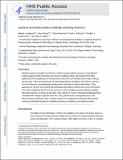| dc.contributor.author | Herman, Pawel | |
| dc.contributor.author | Lundqvist, Lars Mikael | |
| dc.contributor.author | Rose, Jonas | |
| dc.contributor.author | Brincat, Scott Louis | |
| dc.contributor.author | Buschman, Timothy J | |
| dc.contributor.author | Miller, Earl K | |
| dc.date.accessioned | 2017-11-17T16:28:04Z | |
| dc.date.available | 2017-11-17T16:28:04Z | |
| dc.date.issued | 2016-03 | |
| dc.date.submitted | 2015-12 | |
| dc.identifier.issn | 0896-6273 | |
| dc.identifier.issn | 1097-4199 | |
| dc.identifier.uri | http://hdl.handle.net/1721.1/112225 | |
| dc.description.abstract | Working memory is thought to result from sustained neuron spiking. However, computational models suggest complex dynamics with discrete oscillatory bursts. We analyzed local field potential (LFP) and spiking from the prefrontal cortex (PFC) of monkeys performing a working memory task. There were brief bursts of narrow-band gamma oscillations (45–100 Hz), varied in time and frequency, accompanying encoding and re-activation of sensory information. They appeared at a minority of recording sites associated with spiking reflecting the to-be-remembered items. Beta oscillations (20–35 Hz) also occurred in brief, variable bursts but reflected a default state interrupted by encoding and decoding. Only activity of neurons reflecting encoding/decoding correlated with changes in gamma burst rate. Thus, gamma bursts could gate access to, and prevent sensory interference with, working memory. This supports the hypothesis that working memory is manifested by discrete oscillatory dynamics and spiking, not sustained activity. | en_US |
| dc.description.sponsorship | National Institute of Mental Health (U.S.) (Grant 5R01MH091174-05) | en_US |
| dc.description.sponsorship | National Institute of Mental Health (U.S.) (Grant 5R37MH087027-07) | en_US |
| dc.publisher | Elsevier/Cell Press | en_US |
| dc.relation.isversionof | http://dx.doi.org/10.1016/J.NEURON.2016.02.028 | en_US |
| dc.rights | Creative Commons Attribution-NonCommercial-NoDerivs License | en_US |
| dc.rights.uri | http://creativecommons.org/licenses/by-nc-nd/4.0/ | en_US |
| dc.source | PMC | en_US |
| dc.title | Gamma and Beta Bursts Underlie Working Memory | en_US |
| dc.type | Article | en_US |
| dc.identifier.citation | Lundqvist, Mikael et al. “Gamma and Beta Bursts Underlie Working Memory.” Neuron 90, 1 (April 2016): 152–164 © 2016 Elsevier Inc | en_US |
| dc.contributor.department | Massachusetts Institute of Technology. Department of Brain and Cognitive Sciences | en_US |
| dc.contributor.department | Picower Institute for Learning and Memory | en_US |
| dc.contributor.mitauthor | Lundqvist, Lars Mikael | |
| dc.contributor.mitauthor | Rose, Jonas | |
| dc.contributor.mitauthor | Brincat, Scott Louis | |
| dc.contributor.mitauthor | Buschman, Timothy J | |
| dc.contributor.mitauthor | Miller, Earl K | |
| dc.relation.journal | Neuron | en_US |
| dc.eprint.version | Author's final manuscript | en_US |
| dc.type.uri | http://purl.org/eprint/type/JournalArticle | en_US |
| eprint.status | http://purl.org/eprint/status/PeerReviewed | en_US |
| dc.date.updated | 2017-11-16T17:41:52Z | |
| dspace.orderedauthors | Lundqvist, Mikael; Rose, Jonas; Herman, Pawel; Brincat, Scott L.; Buschman, Timothy J.; Miller, Earl K. | en_US |
| dspace.embargo.terms | N | en_US |
| dc.identifier.orcid | https://orcid.org/0000-0003-1298-2761 | |
| mit.license | PUBLISHER_CC | en_US |
